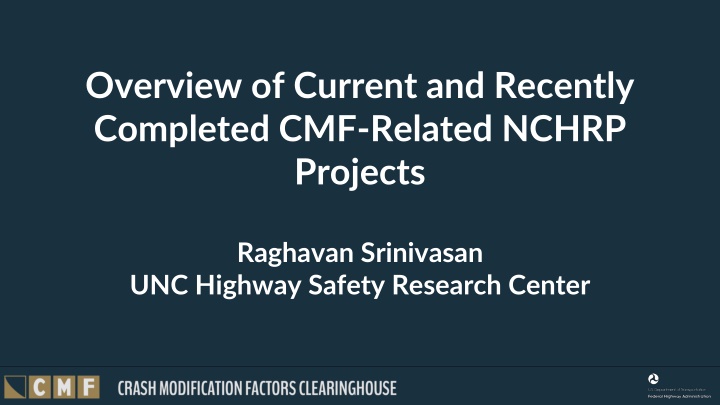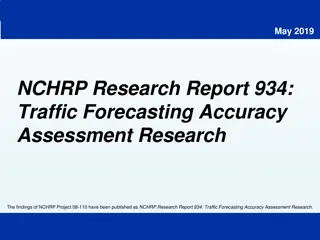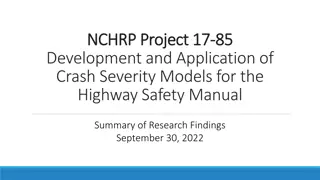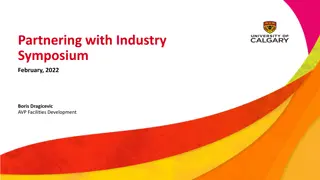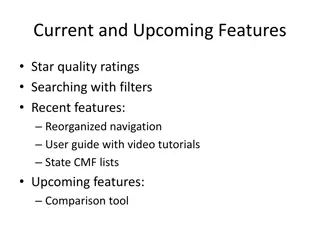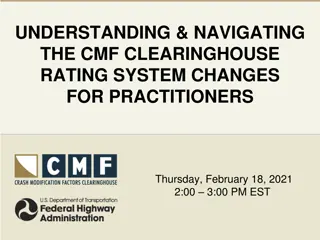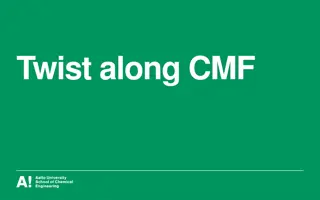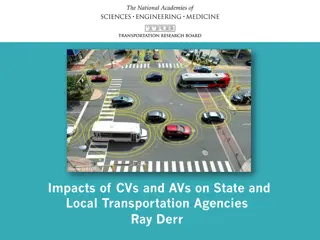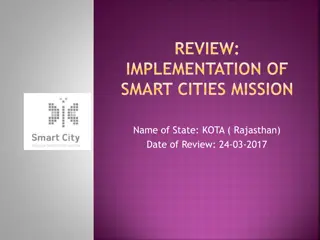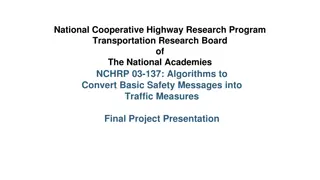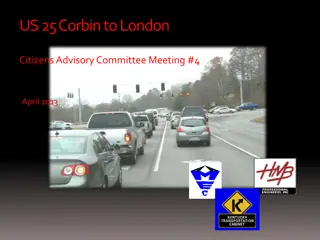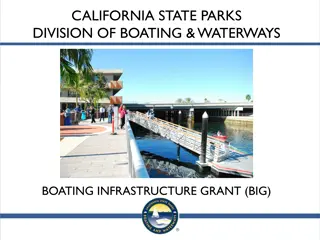Comprehensive Overview of Current and Recent CMF-Related NCHRP Projects
This detailed overview covers three NCHRP projects focused on Crash Modification Factors (CMFs). It includes project descriptions, completion statuses, and objectives such as developing guidelines for CMF calibration, combining treatments, and formulating future CMFs. The content also delves into specific guidance for CMF selection and adjustment, combined treatment effects, and crash modification function development for safety practitioners and researchers to enhance highway safety measures.
Download Presentation

Please find below an Image/Link to download the presentation.
The content on the website is provided AS IS for your information and personal use only. It may not be sold, licensed, or shared on other websites without obtaining consent from the author.If you encounter any issues during the download, it is possible that the publisher has removed the file from their server.
You are allowed to download the files provided on this website for personal or commercial use, subject to the condition that they are used lawfully. All files are the property of their respective owners.
The content on the website is provided AS IS for your information and personal use only. It may not be sold, licensed, or shared on other websites without obtaining consent from the author.
E N D
Presentation Transcript
Overview of Current and Recently Completed CMF-Related NCHRP Projects Raghavan Srinivasan UNC Highway Safety Research Center
Overview of 3 NCHRP Projects NCHRP 17-63: Guidance for the Development and Application of Crash Modification Factors Project completed in 2017 NCHRP 17-72: Update of Crash Modification Factors for the Highway Safety Manual (HSM) Project will be completed soon NCHRP 17-95: Crash Modification Factors (CMFs) for Intelligent Transportation Systems (ITS) Ongoing, and will be completed in 2022 or 2023
NCHRP 17-63: Guidance for development and application of CMFs Led by Daniel Carter (now with NCDOT) Objective 1. Develop guidelines for calibration of current CMFs to assess treatment effectiveness at sites for which key site characteristics may be different. Objective 2. Develop guidelines for how existing and future CMFs can be combined in a single location with multiple treatments. Objective 3. Develop recommended procedures for formulating and calibrating future CMFs that identify key influential site characteristics.
Objective 1: Guidance on CMF Selection and Adjustment Audience is safety practitioners Guides user in the selection of CMFs for a site of interest Adjusts CMF for site of interest based on crash distribution
Objective 2: Guidance on CMF of Combined Effect of Two Treatments Audience is safety practitioners Provides discussion of the issues encountered when considering combined effect Procedure guides user in calculating combined effect based on magnitude of CMFs and potential overlap Discussion on how to expand to more than two treatments
Objective 3: Guidance on Development Crash Modification Functions Audience is safety researchers Provides guidance on developing crash modification functions (CMFunctions) from observational studies Discusses key issues and how to overcome or mitigate them Demonstrated through four case studies
Research Products from NCHRP 17-63 Procedure for Estimating the Effect of a Proposed Treatment at a Subject Site (Appendix A) Procedure for Estimating the Combined Safety Effect of Two Treatments (Appendix B) Guidance for Developing Crash Modification Functions (Appendix C) CMF Regression Software Supports procedures of Appendix A. Computes average CMF; disaggregates total CMFs into specific crash type or severity category CMFs; computes CMFs as function of site characteristics CMF Combination Tool Supports procedures of Appendix A. Compares CMFs for statistical similarity; computes combined CMF.
Availability of Products from NCHRP 17-63 NCHRP has decided to publish the products as NCHRP Research Report 991 Prepublication draft: https://www.trb.org/Publications/Blurbs/182603.aspx Videos explaining some of the procedures developed in NCHRP 17-63 (developed with support from FHWA): https://www.youtube.com/watch?v=OPvAjUpT6Dg https://www.youtube.com/watch?v=48M7TBKTCM0 http://www.cmfclearinghouse.org/using_cmfs.cfm (look for section called Trainings)
Poll Question How does your agency estimate the combined safety effect of two treatments (select all that apply)? Use quantitative procedures based on NCHRP 17-63 or other sources Engineering judgment
NCHRP 17-72: Update of CMFs for the HSM Objectives Assess existing process for identifying CMFs for inclusion in the 2nd edition of the HSM (HSM2) Develop proposed revisions to the criteria and process Apply the revised evaluation criteria and develop a list of CMFs for the 2ndedition of the HSM Conduct CMF gap analysis Develop guidance document for practitioner use Conduct single-state calibration for the 2ndedition of the HSM Develop CMFs for roadside crashes
Developed New Rating System for CMFs Reviewed rating procedures developed by others (including the CMF Clearinghouse rating system developed in 2009) Detailed procedure with more explicit consideration of factors Details provided in earlier presentation
Developed Guidance Document (Part D of HSM2) Chapter 1: Introduction Chapter 2: Selecting CMFs Chapter 3: Applying CMFs Chapter 4: Developing CMFs Appendix A: NCHRP 17-72 rating system Appendix B: Adjusting CMFs to local conditions Appendix C: Combining multiple CMFs for the same countermeasure May be modified by the HSM2 production contractor (Texas A&M)
Single/Common State Calibration of HSM SPFs (New Task) In the 1stedition of the HSM Segment SPFs were calibrated to Washington Intersection SPFs were calibrated to California Facilitate relative comparison of predictions without calibration Conduct a similar calibration effort for HSM2 Significantly more facility types and prediction models
CMFs for Roadside Characteristics (New Task) In the 1stedition, roadside hazard rating (1 through 7) is used Photographs for the different hazard conditions Somewhat subjective procedure Develop a more objective system NCHRP 17-54 developed CMFs for roadside characteristics HSM AASHTO committee found inconsistencies in the results from NCHRP 17-54 NCHRP 17-72 was asked to develop CMFs based on results NCHRP 17- 54 and previous research
Conduct CMF Gap Analysis Determine overall quality of CMFs in different categories Determine the gaps, and provide insight into future research areas Submitted to NCHRP last week
Next Steps for NCHRP 17-72 Panel is reviewing the deliverables The final report from NCHRP 17-72 should be published next year
NCHRP 17-95: CMFs for ITS Applications Objectives Develop CMFs for commonly deployed ITS applications Provide case studies of safety benefit/cost ratios of such ITS applications Consider ITS applications deployed on freeways, arterials, and rural highways Variable/dynamic/changeable message signs; Closed-circuit television (CCTV) cameras; Traffic monitoring stations; Ramp meters; and Road weather information systems (RWIS)
Surveys and Interviews Web-based survey: Learn more about ITS treatments implemented in specific jurisdictions; Determine what data are available for ITS treatments; and Identify datasets that could be used to develop CMFs for specific ITS treatments Participant invitations sent to: AASHTO Committee on Transportation Systems Operations (CTSO) FHWA Transportation Management Center (TMC) Pooled-Fund Study ENTERPRISE Pooled Fund Study Forwarded to MPOs or local agencies Follow-up interviews to get more insight into agency data
Developed Phase II Work Plan Data collection plan Identify treatments for evaluation Possible sources of data Procedures for data acquisition Data analysis plan Various methods for analyzing the data to develop CMFs Plan for developing benefit cost ratios
Data Analysis Methods Before-after with Empirical Bayes or Full Bayes Accepted in the research community Treatments may be implemented with other changes Need data on installation time period - some may have been installed many years ago Sample size may be limited Cross-sectional regression modeling Correlation, but not causation Larger samples May not need precise data on installation years In theory, can deal better with multiple treatments
Current Activities in NCHRP 17-95 Working on compiling data Remaining tasks will follow data collection Project expected to be completed in 2022 or 2023
